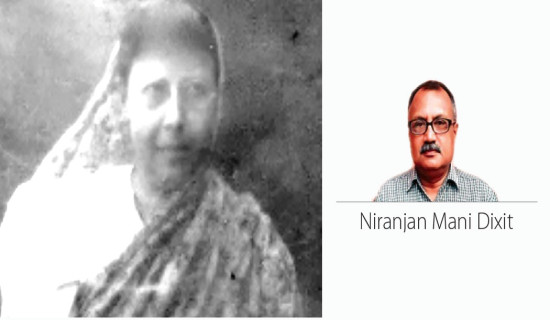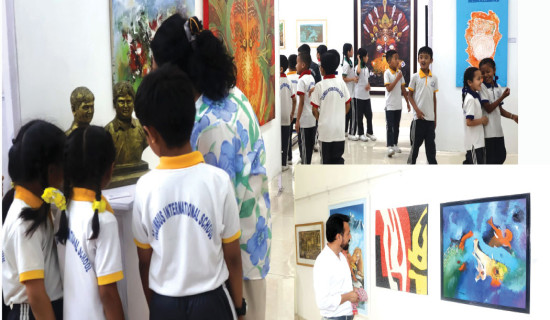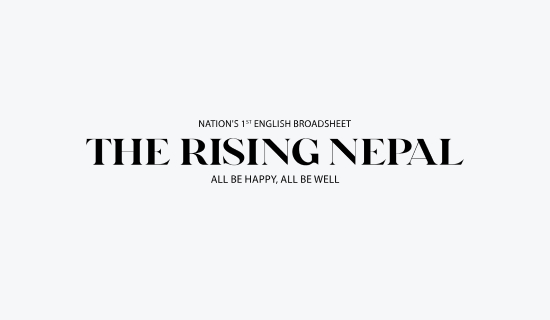- Friday, 27 June 2025
The Maxims For Good Health
Journalist Gandhiraj Kafle's book 'Suswasthya: Manobal, Chintan Ra Byaktitwa' (Good Health: Mental Strength, Thought, and Personality) contains engaging topics and references. It naturally appeals to readers interested in health, yoga, meditation, naturopathy, and mindfulness. The book is divided into two parts. The first one, titled 'Byaktitwa' (Personality), discusses the inspiring aspects of 13 individuals from Nepal and around the world, focusing on their approach to health. In the second, 'Bichar' (Thought), Kafle offers his ideological perspectives on health.
The article 'Mahatma Gandhiko Swasthya Satya' (The Health Formula of Mahatma Gandhi) highlights Gandhi's stance on health in an inspiring manner. He believed in resolving physical problems through natural food and lifestyle rather than medication. He often recovered using natural methods, even clashing with doctors. The Gandhi family was vegetarian. When Gandhi's son Manilal, then ten, suffered from typhoid and pneumonia, he became severely malnourished, and medication proved ineffective. Doctors recommended feeding him egg and chicken soup, but Gandhi refused, saying, "If he were an adult, you could proceed with his consent. But as a child, I cannot allow this." Ultimately, Gandhi resorted to hydropathy with him, which succeeded.
Revolutionary leader and renowned author BP Koirala once wrote in the first part of his autobiography 'Aafno Katha' (My Own Story), "Only a healthy body can foster healthy thought." This suggests BP was essentially a materialist. Yet, despite suffering from cancer for nearly 37 years, he led the 1950 revolution, won a landslide victory for his party in the 1959 general elections, and endured exile, imprisonment, and resistance against the Panchayat regime. His exceptional inner strength and high moral courage made such feats possible.
The write-up on former Indian Prime Minister Morarji Desai is particularly intriguing. Vegetarian by birth, Desai lived to age 99 and remained fit, attractive, and healthy. He practised agriculture, drank his urine, slept on a thin mattress, and followed a disciplined routine. In his student days, he cured himself of migraines not through doctors but by drinking plenty of water and fasting for five days. His lifestyle is a testament to healthy living, driven more by science than willpower. The common belief that vegetarians lack nutrition is false. Modern medicine confirms that with a protein-rich diet, sun exposure, and walking barefoot daily, vegetarians can achieve better health than non-vegetarians.
Renowned Indian industrialist JRD Tata also followed a commendable health routine. Even in his 80s, he cycled regularly, did sit-ups energetically, and enjoyed skiing. He spent three weeks annually skiing in Austria, Italy, and Switzerland. Vipassana meditation, a significant contribution to Buddha's teachings, is prominently featured in the life of Satyanarayan Goenka. Once severely afflicted with migraines, Goenka was cured through it and dedicated his life to spreading it across many countries for public health and well-being.
The second section of the book contains eight essays, among which those centred on Patanjali's Ashtanga Yoga and Maharshi Charak are critical. Yoga Guru Ramdev has extensively explained Ashtanga Yoga in his book 'Yoga Sadhana Ra Yoga Chikitsa Rahasya'. For those who haven't read that, Kafle's summary is helpful. The eight limbs begin with 'Yama', which advocates non-violence, truthfulness, non-stealing, and non-possessiveness. Niyam promotes self-discipline, contentment, scriptural study, and devotion to God. Asan has well-managed physical postures. Pranayam helps control breath and cleanse both body and mind. Pratyahar is cleansing the mind and detachment from external pleasures. Dharana is concentrated on a single object. Dhyan is meditation, an advanced form of Dharana. Samadhi is the ultimate state of consciousness that helps you free yourself from stress, doubt, and duality.
In the essay on Maharshi Charak, Kafle highlights Vagbhata's vital health principle, 'Hitabhuk, Mitabhuk, Ritabhuk,' which means eat what is beneficial, eat in moderation, and eat what is ethically earned, properly cooked and appropriate to the season. This is seen as one of the most important maxims for good health.
Although the subject matter is compelling, the essays do not consistently support the book's central theme. Personalities such as Ganesh Man Singh, Manmohan Adhikari, Krishna Prasad Bhattarai, Girija Prasad Koirala, Tolstoy, and Bismarck, while inspiring in their struggle, are not ideal examples from a health perspective. In contrast, Beer Narayan Chaudhary, an ordinary man from Sunsari who lived to be 139, would have been a more fitting example. He ate rice, lentils, and vegetables regularly, and meat and fish occasionally. He basked in sunlight regularly, which is not mentioned in the book. These were the keys to his long life.
The health perspectives of the featured personalities are not thoroughly explored. The essays primarily centre on their struggles; the health approach appears only incidentally. The sources of the article are secondary. Ideally, such essays would be better if they were based on firsthand sources and focused on individuals whose lives were examples from a health aspect and were well-researched. I think the appropriate personalities for this book might be Dr Gaurishankar Lal Das, Satya Mohan Joshi, poet Madhav Ghimire, Khaptad Baba, the Buddha, Ramdev, Balkrishna Acharya, Hippocrates, Stephen Hawking, and others.
The author emphasises inner strength as the primary key to good health, followed by a proper diet. The foremost condition for good health is proper nutrition, which Hippocrates, the father of medicine, emphasised long ago. After that, physical exertion, through yoga, exercise, or labour, is crucial, along with pranayam, positive thinking, and laughter.
However, the over-mention of inner strength in the book sounds stereotyped. Undoubtedly, the willpower of the personalities, including Helen Keller, featured in the book is inspiring, but they are exceptional. The flaw in much of our art and literature is the portrayal of exceptions as general tendencies. For ordinary people, physical well-being is paramount. In reality, healthy people possess strong willpower, but when health deteriorates, so does the will. A boy who couldn't sleep all night loses the willpower to face his girlfriend in the morning. A person with a sinus has no willpower to speak in mass. After all, inner strength is essential when a person gets diseased.
The essays often digress and only get to the core much later. For a second edition, if the author rewrites it with deeper effort and research, this profound topic can yield a magnificent book.















